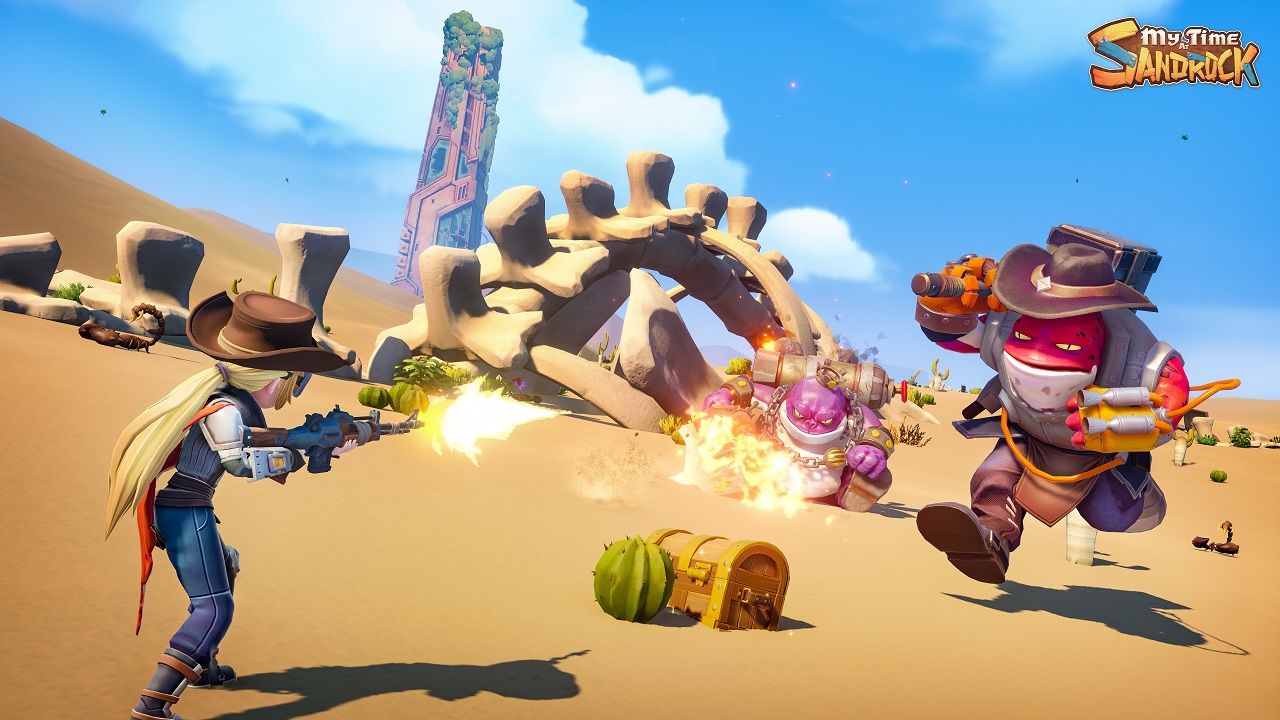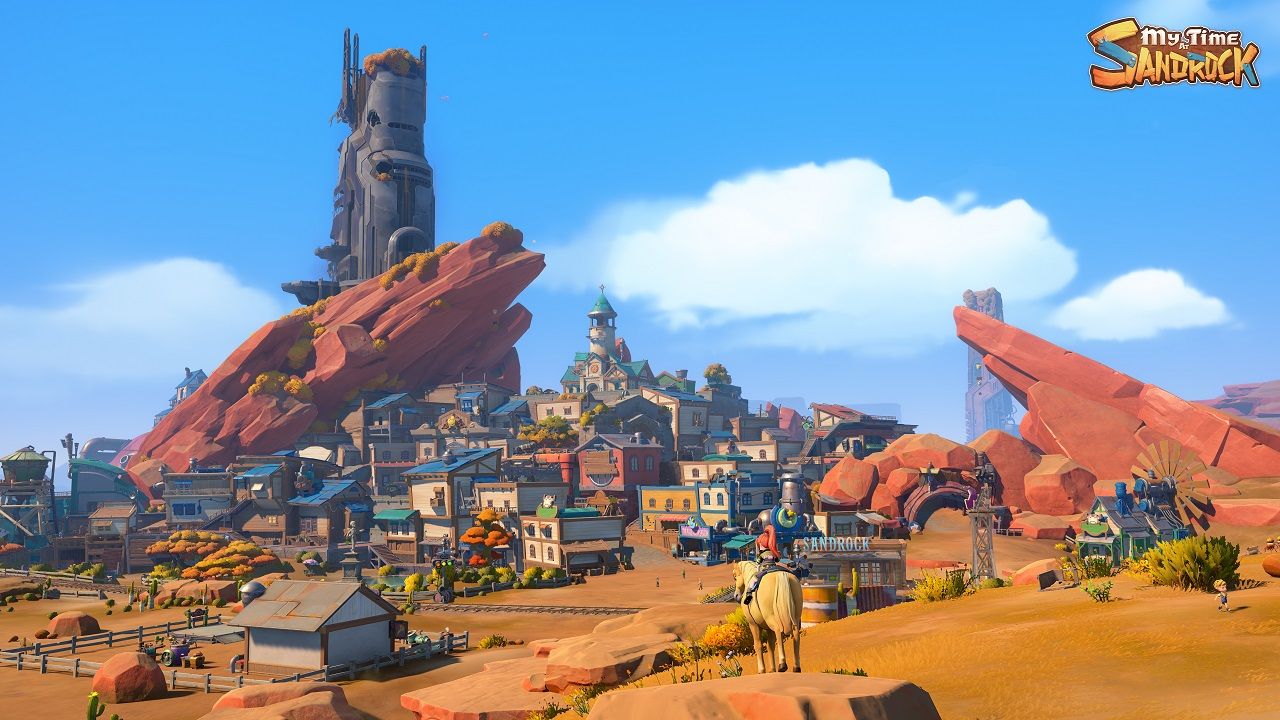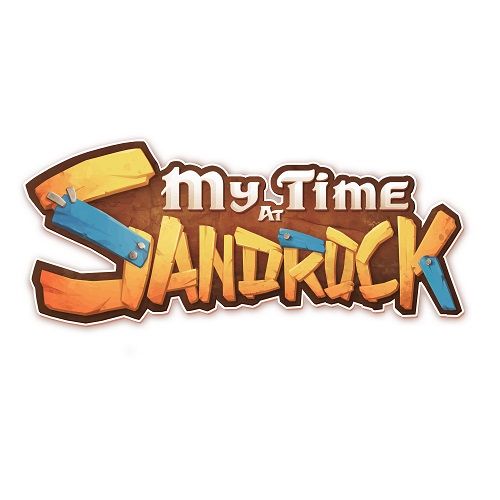My Time at Sandrock Review
There is a part of us all that craves the peaceful life. Wake up, say hi to the neighbors, do some chores, put some time into a meaningful project, produce something small toward a greater good, then go to bed after a hard day’s work, looking forward to tomorrow. That isn’t the reality most of us find ourselves in, but through the magic of video games, we can experience these simple pleasures and escape from the real world. My Time at Sandrock gives players a slice of what that life has to offer, along with a playful taste of the strange and mysterious.
This game is a follow-up to Pathea’s previous entry to the series My Time at Portia. While the two games take place in different parts of the world, there are connecting threads, both through the gameplay mechanics and through a few characters and a shared world history. Sandrock is one of the Free Cities, located in a dry desert, a stark difference to the lush, green fields and plains of Portia. The peoples of the Free Cities are remnants of an old civilization. Their hubris led them down a path of dangerous technological advances, ultimately destroying them. Sandrock is a settlement built right on top of an Oldworld city. Because of this, there is no end to the scrap of wood, stone, and metal unearthed by the shifting sands.

We Built This City
The premise of My Time at Sandrock is nearly identical to Portia. You come to a new town as one of the new resident Builders. As a Builder, you take Commissions and jobs from the townsfolk to earn your living. Build whatever they need, whether that may be furniture, mechanical parts, machines, or other resources. I played My Time at Portia and really enjoyed it. To minimize the risk of this becoming a compare and contrast between the two games, My Time at Sandrock has a more mechanically refined gameplay loop than its predecessor. Quality of life improvements that might make in-game tasks almost too easy, but you’re not meant to break your back playing this game. The changes help the game feel cozy and laidback.
Though the gameplay is very similar to My Time at Portia, Pathea does a good job making sure that Sandrock is not just Portia with a desert skin. Salvaging and recycling Oldworld junk is a central part of My Time at Sandrock and shakes things up for those of us from Portia. Crafting and building works the same as the first game, but with the addition of the Recycler machine and Pickhammer tool, the amount of salvaging the player does and its utility in the community really makes you feel that Sandrock has a different way of doing things than the other Free Cities.

New and Improved
Building is not the sole activity you can take part in in Sandrock. You might think that farms out in the desert would not thrive, but through a new, unconventional method called Sandfarming. Players can grow and harvest crops, albeit a little differently than in Portia. Combat is another gameplay mechanic that has been revamped since the previous game.
The fallout from the Oldworld has left the Free Cities full of dangers. Whether you are hunting wild animals for resources, defending yourself from robots in the ruins, or fighting for your life against mutant creatures, you will need to be prepared with weapons. My Time at Sandrock has a new Break system for combat. Your enemies have a Break meter which will make your target stagger when they are hit enough. This leaves them vulnerable to more damage, but be careful because your character has a Break meter too.
Sandrock has a wide variety of weapons you can use in combat. There are a Sword and Shield, Spear, Dual Daggers, Broadsword, Hammer, and Firearms. All type have their own advantages and drawbacks to using them. It is really a matter of preference though. Combat is by no means challenging, but again, this isn’t meant to be a stressful or hard game to play.

The Frontier Experience
Nearly every action you take will earn you Experience, whether that is building an item, completing a commission, slaying a monster, or salvaging scrap. This experience contributes to your overall level, which will increase certain attributes, such as HP or Stamina. However, those actions will also contribute to a specific skill tree. Building items increase your Workshop level. Killing monsters increases your Combat level. Completing quests for other characters increases your Social level, and so on.
This leveling mechanic gently pushes players toward skills you wish to improve, while also rewarding them for playing the way they want. When a specific skill tree earns a Skill Point, it can be invested into a perk. Perks will have various bonuses, such as increased damage with a specific type of weapon or getting more relationship points when interacting with other characters.
As you complete story-related missions, more locations, jobs, and resources will become available to you. There becomes a natural flow of building machines, expanding your property, upgrading machines, to take on more interesting projects. Eventually, you will find yourself with a nifty operation of processing, forging, sawing, and assembling.

Sandrockers
The singleplayer campaign is the core experience, but Pathea is also refining a multiplayer portion of My Time at Sandrock. While they could have just made the same game, but with room for more players, the multiplayer is quite a different experience. Multiplayer games also take place before the singleplayer game. Players will notice that many of the buildings, landmarks, and pathways are missing. The building projects in multiplayer are actually things that will come to be in the main game.

The gameplay is largely the same, but up to four players can work together, sharing resources and money. Progression is also streamlined and easier for a team to build and upgrade their Workshop. Unlike singleplayer, overall levels offer Skill points to invest into perks to remove any obstacles in getting more out of a multiplayer session.
If the multiplayer aspect is a turn-off for you, you will be happy to know that you don’t actually need other players for this mode. Playing on your own is enough to get the experience of this mode, which is different enough to warrant giving it a try. Again, multiplayer is a work-in-progress and won’t be available on console at launch. However, knowing Pathea and the commitment they have to improving their games in the long run, I believe it will have the same quality as the singleplayer portion some point soon after the game launches.
A Fine Piece of Machinery
After playing Portia, and then seeing My Time at Sandrock announced, I was skeptical. How can Pathea make this work again? And in a desert of all places? Well, I have to say I was surprised and impressed. Pathea has a very creative team behind this world of theirs. On top of the quality of life improvements, and the new multiplayer component, My Time at Sandrock recaptures the feeling of “I’ll do one more day” at the end of every day. Not only that, but now I’m excited for the prospect of My Time at Highwind or My Time at Atara, just to see what can be done with a new part of this world.
***A Steam code was provided by the publisher***
The Good
- Relaxing, easy-going experience
- Improved UI and combat mechanics
- Great multiplayer concepts
The Bad
- Just a little too easy
- Multiplayer still needs polish

